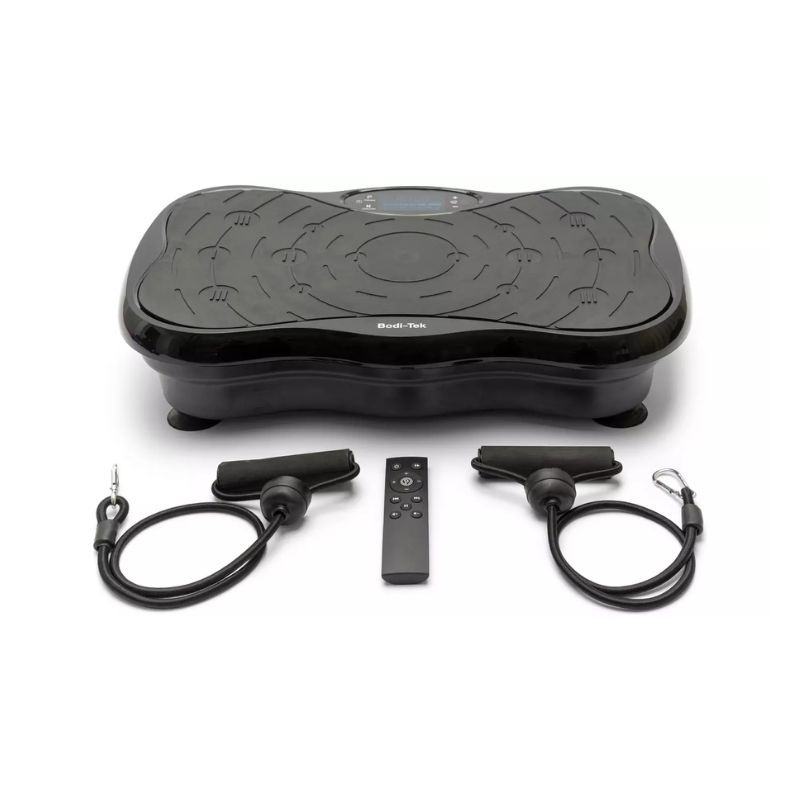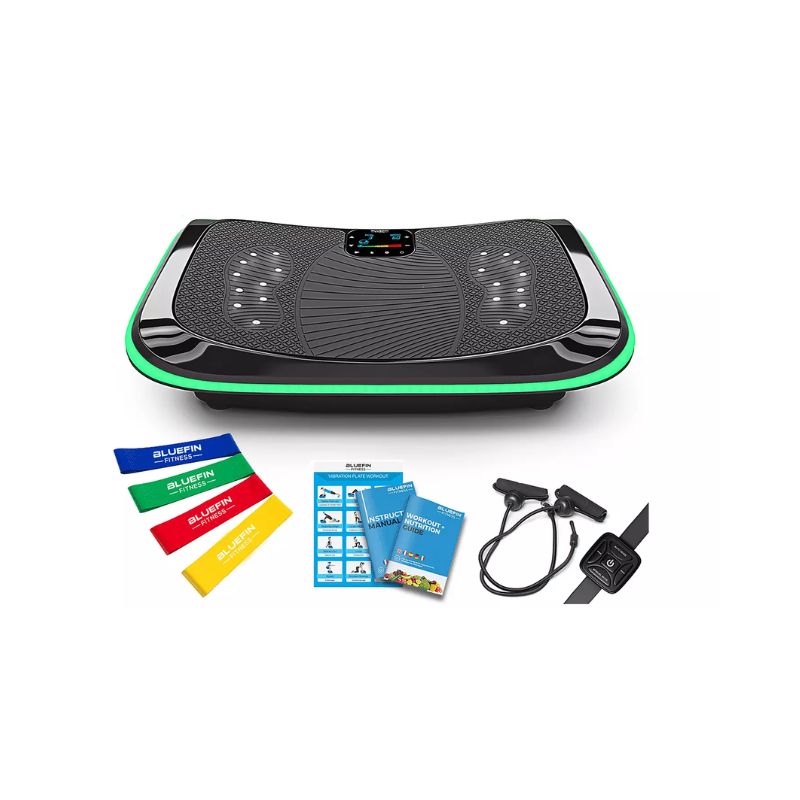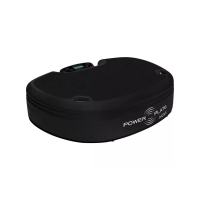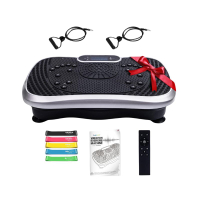I discovered Power Plate workouts a decade ago - here are the benefits no one talks about today
Power Plate workouts are everywhere - once again. But what are the real benefits of this vibration training? Writer Jennifer Barton reveals all


A Power Plate is an exercise machine that stimulates muscles to contract and relax dozens of times a second. Devotees say it's a great way to get fit and build muscle, while sceptics call it a "gimmick". Writer Jennifer Barton takes a look at the benefits and drawbacks of such a workout in perimenopause and beyond.
I'm a fitness-fad junkie. Ecstatic dance, aerial silks, roller skating, and most recently, I joined a run club for the first time in my 40s. So of course, ten years ago when the Power Plate first hit the mainstream, I was all over it. I immediately loved the feel of my muscles shaking at high speeds as I squatted, lunged, and relevé on the vibration plate.
Whole-body vibration workouts can be particularly beneficial for those in perimenopause and post-menopausal women, helping combat bone density loss, increase muscle strength, alleviate achy joints, improve balance and stimulate a sluggish lymphatic system - similar to strength training. Here, woman&home speaks to the experts to reveal all the benefits that really exist with power plate works - and where the gimmicks are.
If you were looking to invest in the best of the best, now would be the time to shop. With Black Friday here, the Power Plate Move is now £749 off in the sale at Currys. You'll also find it in red and white at a discount.
For a vibration plate under £100, this one from WeightWorld is a go-to. It has five programs, almost 100 intensity levels to challenge yourself, and strength training accessories to work your upper body.
What is a Power Plate?
Power plates, also known as vibration plates, are exercise machines that generate all vibrations to the body at a high volume, says Nancy Best, a certified personal trainer and the founder of Ladies Who Crunch. "The vibrations are a form of stimulation, helping to activate multiple muscle groups simultaneously," she explains.
You can adjust your speed – most machines generate anywhere from 20-50 vibrations per second – and the exercises you’re doing, which is why vibration plates are well-suited to people of different ages and fitness levels.
Power Plate was one of the first to come out with vibration plates and remains the front-runner in the industry - we call them power plates more often than their general name. These used to be a gym equipment staple. So ubiquitous a decade ago that dedicated Power Plate studios – with wall-to-wall vibration plates – were dotted around London when I first discovered it. Class times ran throughout the day, a PT led each session and you were in and out the door in just over 30 minutes, having completed a fun and dynamic workout in that time. Good times.
Where to buy

All singing, all dancing - the Power Plate MOVE is the bestselling machine from the brand themselves. It's a compact size, perfect for using at home, and has six frequency modes to choose from - helping you design the perfect workout for your need - and everything you need for the set-up.
While it's a serious investment, it's on a level with advanced indoor bikes and treadmills.

At just shy of £180, this is a budget-friendly vibration plate for anyone looking to get in their training at home. Complete with up to 99 intensity levels, suitable from beginner to pro, and five auto-run programmes for easy exercises.
This set-up comes with two resistance bands as well, so you can work your upper and lower body at the same time.

A good middle ground between the two is the Bluefin Fitness 4D Vibration Plate. This vibration plate has three separate motors for different functions - including vibration, oscillation, and micro vibration - which can be used independently or all at the same time. It also has Bluetooth speakers to connect to your music and comes with two lots of resistance bands for an upper body workout.
These days, the vibration plates are no longer bulky and upright like the ones I used to train on. The newer versions are designed for home use - they’re compact, portable, and budget-friendly, with prices typically starting at £100.
Sign up to our free daily email for the latest royal and entertainment news, interesting opinion, expert advice on styling and beauty trends, and no-nonsense guides to the health and wellness questions you want answered.
But the vibration technology isn’t just found in the platforms anymore either. You can buy indoor cycling equipment from Power Plate like the REV bike - an amped-up bike experience with vibrations through the pedals. Recovery aids like vibrating rollers and massage guns also operate in a similar way.
Benefits of power plate
1. Low-impact workout
If you’re looking to find an exercise routine you can stick to, then including low-impact workouts – Pilates, swimming, cycling and vibration plates, despite the high speeds they reach – is one way to do it. These workouts put minimal strain on joints, keep injury risk low and allow many people to build up strength, endurance and fitness confidence.
Fitness accessories like resistance bands, slam balls, hand straps and Swiss balls also lend themselves well to Power Plate exercises, especially if you’re looking to add some more low-impact exercises to your workout.
2. Versatile
Ask any fan of Power Plate and they’ll tell you the best thing about them: versatility. It’s never boring. You can train your whole body or target specific muscle groups in one session.
If anything proves this, it's how these vibration plates are used to train professional athletes like Olympic figure skaters, PGL golfers, and NFL and tennis players (reportedly, Serena Williams is a fan). It’s no exaggeration to say you can use this equipment to improve your golf swing or ski stance, do barre and Pilates moves, or start strength training. Name another piece of workout kit that can do that.
Vibration plates can also be used for stretching (with one review from Brigham Young University finding that whole-body vibration plate workouts improved flexibility) and injury recovery. Targeted vibrations can also help to increase blood flow and allow tension release - even at home, with many home plates including a "massage" function.
3. The workouts don't have to be long to see results
The idea behind Power Plate vibrations is that they allow you to build and strengthen muscles faster – that’s why devotees insist all you need is 15 minutes on the board a day, a few times a week, to start seeing toning and strength benefits.
The studies on this slightly differ, with many (including research from the University of Verona and Jeonbuk National University Medical School) suggesting that 20 to 50 minutes is needed to see results. Still, it's on par with doing other low-impact workouts like Pilates every day for half an hour or cycling as a workout.
A review in the Journal of Clinical Medicine just last year also concluded that vibration plates did help increase lower body strength when used regularly - but not upper body strength.
4. Improves bone density
With our better understanding of menopause and the emotional and physical changes that accompany this stage of life, the earlier we can make lifestyle interventions (more protein! strength training!) the better we feel long-term.
In 50+ women, declining bone density (aka osteopenia) is linked to osteoporosis and an increased risk of fractures.
“Women can lose up to 20% of their bone density within five to seven years following menopause,” says Best. "Using a Power Plate has been shown to improve bone density, so it can be a great way to counteract the musculoskeletal impact of ageing. As our bones become more brittle, lower-impact forms of exercise are important. The vibrations on the machine might feel intense, but they are totally safe for this stage of life."
The US Food and Drug Administration recently approved a vibrational belt to help treat low bone density in postmenopausal women - although this doesn't necessarily mean it's a good option for everyone. Always do your own research before buying new products purported to have certain health benefits.
5. Power plate workouts can improve balance and stability
The shaking plates can challenge your balance and stability like nothing else. They put extra pressure on the body, helping to strengthen and 'tone' the muscles, says Best. Taking core workouts for instance, "The challenge of completing simple exercises like dead bugs or Russian twists on a Power Plate-type machine is significant. Your body is more unstable, so all your muscles must work harder to keep balance and power," says Best.
In the years to come, this improved stability can help to prevent slips and falls from a loss of balance.
That's far from all the benefits though, with research ongoing looking at vibration training for benefits from improving glycaemic values in Type 2 diabetics to improving walking endurance in those with MS.

It's important to supplement lower body Power Plate workouts with upper-body strength training.
Do vibration plates work?
Yes, there is plenty of evidence to suggest that vibration plate workouts can offer numerous benefits provided they are used little and often, and done alongside other types of exercise - such as one of the many types of strength training.
"A lot of women are looking for a quick-fix solution," says Anna Jenkins, a PT who works primarily with women going through menopause as the founder of We Are Fit Attitude. "But the most important thing to know is how to strength train in a way where you can see that progression is possible and teach yourself how to eat foods without feeling like you're on a restricted diet. Those two things are far more important than getting on a vibration plate."
Who is Power Plate suitable for?
Vibration plates put users at risk of injury if used improperly, too, which is why it’s best to use them with a trainer, if possible. "I often see people trying to add in further resistance to the vibrations, with dumbbells or kettlebells. This can be dangerous if you’re a beginner or in the early stages of your exercise journey. Start with mat-based bodyweight exercises before you start adding in additional stimulus, whether that’s free weights or a vibration machine,” Best advises.
The safety of the equipment is another factor, so do your research before committing to a purchase.
Vibration plates also suffer from a perception problem. For every piece of evidence to support the benefits of this equipment, there is someone on social media filming themselves 'exercising' by standing on a vibration plate, doing inefficient workouts and lamenting the lack of results.
If you have weight loss or any body composition changes in mind, exercise - whether that's using vibration plates or not - must be done in combination with changes to your diet and other lifestyle habits - such as your sleep routine and stress levels. To lose weight, you have to be in a calorie deficit.
Jennifer is a London-based freelance journalist, originally from New York. Her byline has appeared in British Vogue, Stylist, WIRED, Grazia and others. She spent a decade training to become a professional ballet dancer and loves to write on all things fitness and wellbeing, from skateboarding to spin class. Jennifer is passionate about mental wellbeing, too, especially when it comes to destigmatizing the shame and silence around mental health conditions.


